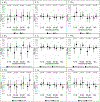Associations of prenatal ambient air pollution exposures with asthma in middle childhood
- PMID: 38460460
- PMCID: PMC11042473
- DOI: 10.1016/j.ijheh.2024.114333
Associations of prenatal ambient air pollution exposures with asthma in middle childhood
Abstract
We examined associations between prenatal fine particulate matter (PM2.5), nitrogen dioxide (NO2), and ozone (O3) exposures and child respiratory outcomes through age 8-9 years in 1279 ECHO-PATHWAYS Consortium mother-child dyads. We averaged spatiotemporally modeled air pollutant exposures during four fetal lung development phases: pseudoglandular (5-16 weeks), canalicular (16-24 weeks), saccular (24-36 weeks), and alveolar (36+ weeks). We estimated adjusted relative risks (RR) for current asthma at age 8-9 and asthma with recent exacerbation or atopic disease, and odds ratios (OR) for wheezing trajectories using modified Poisson and multinomial logistic regression, respectively. Effect modification by child sex, maternal asthma, and prenatal environmental tobacco smoke was explored. Across all outcomes, 95% confidence intervals (CI) included the null for all estimates of associations between prenatal air pollution exposures and respiratory outcomes. Pseudoglandular PM2.5 exposure modestly increased risk of current asthma (RRadj = 1.15, 95% CI: 0.88-1.51); canalicular PM2.5 exposure modestly increased risk of asthma with recent exacerbation (RRadj = 1.26, 95% CI: 0.86-1.86) and persistent wheezing (ORadj = 1.28, 95% CI: 0.86-1.89). Similar findings were observed for O3, but not NO2, and associations were strengthened among mothers without asthma. While not statistically distinguishable from the null, trends in effect estimates suggest some adverse associations of early pregnancy air pollution exposures with child respiratory conditions, warranting confirmation in larger samples.
Keywords: Developmental origins of health and disease; Particulate matter; air pollution; asthma.
Copyright © 2024 The Authors. Published by Elsevier GmbH.. All rights reserved.
Conflict of interest statement
Disclosure of interest
The authors report there are no competing interests to declare.
Figures

Similar articles
-
Mortality and Morbidity Effects of Long-Term Exposure to Low-Level PM2.5, BC, NO2, and O3: An Analysis of European Cohorts in the ELAPSE Project.Res Rep Health Eff Inst. 2021 Sep;2021(208):1-127. Res Rep Health Eff Inst. 2021. PMID: 36106702 Free PMC article.
-
Mutual Associations of Exposure to Ambient Air Pollutants in the First 1000 Days of Life With Asthma/Wheezing in Children: Prospective Cohort Study in Guangzhou, China.JMIR Public Health Surveill. 2024 Apr 17;10:e52456. doi: 10.2196/52456. JMIR Public Health Surveill. 2024. PMID: 38631029 Free PMC article. Clinical Trial.
-
Early-Life Exposure to Ambient Air Pollution from Multiple Sources and Asthma Incidence in Children: A Nationwide Birth Cohort Study from Denmark.Environ Health Perspect. 2023 May;131(5):57003. doi: 10.1289/EHP11539. Epub 2023 May 10. Environ Health Perspect. 2023. PMID: 37162236 Free PMC article.
-
Ambient air pollution exposure and adult asthma incidence: a systematic review and meta-analysis.Lancet Planet Health. 2024 Dec;8(12):e1065-e1078. doi: 10.1016/S2542-5196(24)00279-1. Lancet Planet Health. 2024. PMID: 39674196
-
Assessing Adverse Health Effects of Long-Term Exposure to Low Levels of Ambient Air Pollution: Implementation of Causal Inference Methods.Res Rep Health Eff Inst. 2022 Jan;2022(211):1-56. Res Rep Health Eff Inst. 2022. PMID: 36193708 Free PMC article. Review.
Cited by
-
Windows of susceptibility and joint effects of prenatal and postnatal ambient air pollution and temperature exposure on asthma and wheeze in Mexican children.Environ Int. 2024 Nov;193:109122. doi: 10.1016/j.envint.2024.109122. Epub 2024 Nov 2. Environ Int. 2024. PMID: 39536662 Free PMC article.
-
Early-Life Ozone Exposure and Asthma and Wheeze in Children.JAMA Netw Open. 2025 Apr 1;8(4):e254121. doi: 10.1001/jamanetworkopen.2025.4121. JAMA Netw Open. 2025. PMID: 40172886 Free PMC article.
-
Prenatal ozone exposure and child lung function: Exploring effect modification by oxidative balance score.Int J Hyg Environ Health. 2025 Mar;264:114491. doi: 10.1016/j.ijheh.2024.114491. Epub 2024 Dec 12. Int J Hyg Environ Health. 2025. PMID: 39671893
-
Long-term PM2.5 exposure impairs lung growth and increases airway inflammation in Taiwanese school children.ERJ Open Res. 2025 Jul 21;11(4):00972-2024. doi: 10.1183/23120541.00972-2024. eCollection 2025 Jul. ERJ Open Res. 2025. PMID: 40692837 Free PMC article.
References
-
- Aguilera I, Pedersen M, Garcia-Esteban R, Ballester F, Basterrechea M, Esplugues A, Fernández-Somoano A, Lertxundi A, Tardón A, Sunyer J, 2013. Early-life exposure to Outdoor air pollution and respiratory health, ear infections, and eczema in infants from the INMA study. Environmental Health Perspectives 121 (3), 387–392. 10.1289/ehp.1205281. - DOI - PMC - PubMed
MeSH terms
Substances
Grants and funding
- R56 ES026528/ES/NIEHS NIH HHS/United States
- UG3 OD035528/OD/NIH HHS/United States
- UH3 OD023305/OD/NIH HHS/United States
- R01 HL109977/HL/NHLBI NIH HHS/United States
- R01 HL132338/HL/NHLBI NIH HHS/United States
- UH3 OD023271/OD/NIH HHS/United States
- P30 ES005022/ES/NIEHS NIH HHS/United States
- R01 ES025169/ES/NIEHS NIH HHS/United States
- UG3 OD023271/OD/NIH HHS/United States
- P01 AG055367/AG/NIA NIH HHS/United States
- T32 ES015459/ES/NIEHS NIH HHS/United States
- R01 ES023500/ES/NIEHS NIH HHS/United States
- P30 ES007033/ES/NIEHS NIH HHS/United States
- P30 ES023515/ES/NIEHS NIH HHS/United States
- K24 HL150312/HL/NHLBI NIH HHS/United States
- R01 ES016863/ES/NIEHS NIH HHS/United States

